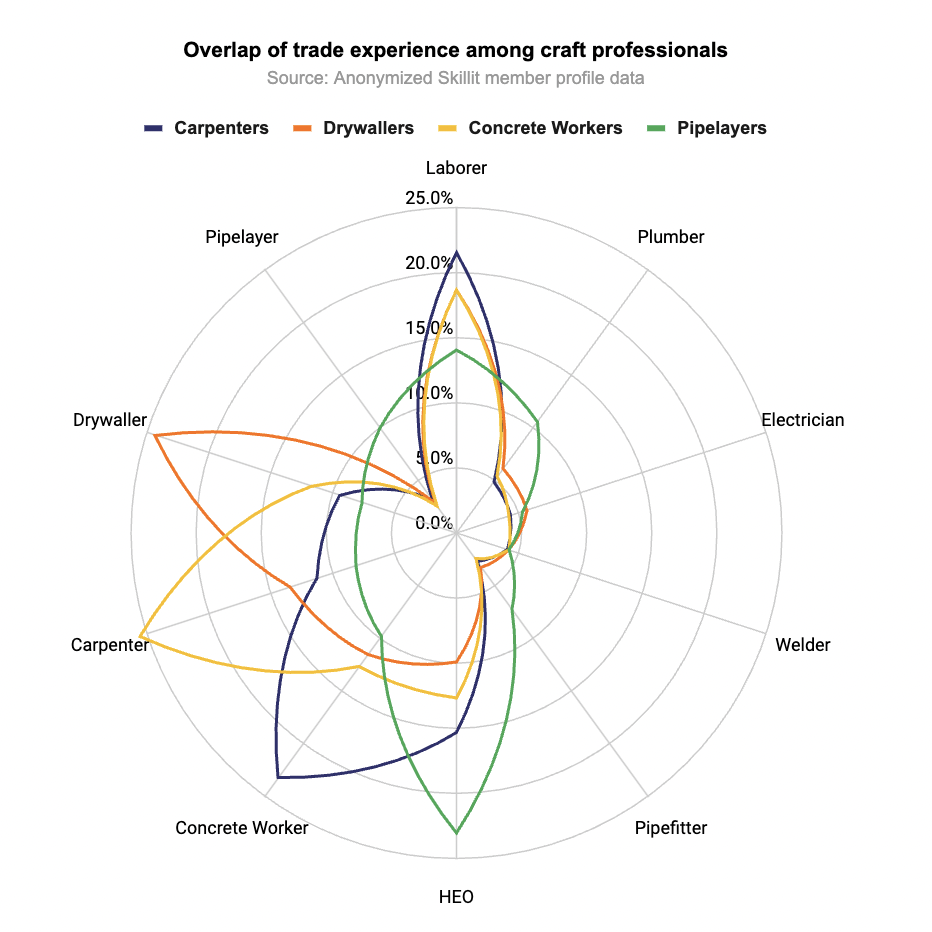Craft labor insights in Miami
Every week, thousands of craft professionals across the U.S. join the Skillit platform to connect with the nation’s best and biggest general and specialty trade contractors. This generates millions of proprietary data points which we anonymize and structure into labor intelligence to help decision-makers gain a competitive edge in a tight labor market.
Key Findings
As of December 21st 2024, craft professionals in Miami:
Desire higher pay than the national average, even though current pay in Miami is somewhat comparable to national levels across trades.
Specifically, electricians want a pay improvement of ($3.5) per hour, welders want ($4.5), and pipefitters ($2).
Willingness to accept lower pay varies greatly across trades. Recruiters should note that welders, laborers, pipelayers and plumbers are less willing to accept lower pay in Miami than nationwide.
Conversely, a higher percentage of pipefitters are willing to accept less pay compared to national levels (28% vs 19%).
These trends may indicate the building boom in the city.
Benefits are consistently the most important non-financial motivation across trades, directly followed by training. Recruiters should consider this to be a good insight when preparing compensation plans - specifically when looking to recruit electricians and welders.
A woman-friendly environment is the least emphasized non-financial motivator. This is also consistent with national data.
Major construction specific employers in Miami include Baker Concrete Construction, Power Design Inc, and Premier Electric amongst others.
In terms of experience, most trades are relatively close between Miami and national figures, with welders standing out as being the most experienced with 22.5 years of experience on average, compared to 19.6 nationally.
The most versatile trade in Miami are laborers, having the most overlap experience with other trades. Conversely, welders and electricians are the most specialized.
Miami craft professionals are 2.49X more likely to want to work in Spanish compared to the national averages, reflecting the region's demography.
Laborers are the group which most prefers Spanish as a first language, 42% in Miami vs. 31% national average.
Laborers have a slightly higher percentage of female representation in Miami compared to national.
Forklift operation and OSHA 10 certifications are the most prevalent among craft professionals in Miami, followed by First Aid.
A majority of craft professionals in Miami are authorized to work, especially in specific trades like HEOs. However, the would rather not say data is 1.43X higher than national, recruiters should note this data point.
Recruiters have an easier time connecting with Miami professionals, compared to national trends and the preferred means of communication are phone calls.
Craft professionals in Miami travel 2.38X longer to get to their job sites.
Almost 50% of the respondents that are willing to relocate to Miami are already based in Florida. The rest come primarily from Georgia, Texas, and North Carolina.
OSHA 10 is a prevalent certification, however, it ranks lower than national levels. Conversely, Miami ranks higher in OSHA 30 (1.42X) and OSHA 62 (1.27X). This suggests stronger degrees of specialization or compliance requirements.
Overall Miami has a diversity of trades that have overlapping skills and experience, particularly laborers. This trade poses an opportunity for up-skilling and training if recruiters are looking to ‘hire from within’.
Current craft pay in Miami
Most trades in Miami have slight fluctuations in hourly pay compared to national averages at 1.01X. There does not seem to be a clear, consistent upward or downward trend across trades.
Craft pay expectations in Miami
Desired hourly pay varies significantly across different trades, and the difference between Miami and the national average also fluctuates. In some instances, Miami's desired pay is considerably higher than the national average, notably for welders, electricians and pipefitters. However, the average desired pay improvement across all trades is 1.11X compared to national.
Ready to grow?
Get in touch to connect with thousands of vetted craft professionals near you.
Craft compensation flexibility in Miami
Laborers and plumbers in Miami are less likely to accept less pay than nationally; (24% and 25%) respectively, compared to (21% and 19%) in Miami. Welders and pipelayers are in the same category (29% and 25%) nationwide, compared to Miami (19% and 24%). Conversely, pipefitters show a higher willingness to accept lower pay in Miami(28%) compared to national (19%).
Non-financial compensation trends
In Miami, benefits are consistently a top motivator across all trades, peaking around 44% for electricians and welders. This is followed by training & upskilling, which is generally around 20%, but slightly higher for plumbers.
Meet Miami’s biggest employers of craft professionals
Our data reveals that Baker Concrete Construction is one of the most prominent employers in Miami with over 300 craft professionals - concrete workers, carpenters, general laborers, heavy equipment operators, drywallers, plumbers and pipelayers on the Skillit platform citing it as a past or current employer.
Skill, Experience & Certifications
Craft professionals in Miami have comparable or slightly higher skill assessment scores than national, particularly in plumbing and drywalling. Pipelayers and electricians score slightly lower than the national average. Laborers, plumbers and pipefitters have significant skills overlap, making them versatile trades. Laborers stand out as having the most transferable skills. In aggregate, craft professionals in Miami have an average of 19.1 years of experience compared to 17.8 nationally. Welders stand out for having the most years of experience. Forklift Operator and OSHA 10 are the most significant certifications, at 34.5% each.
Work authorization
The percentage of professionals authorized to work is generally high in both Miami (53.19%) and nationally (63.01%), with slight variations by trade. Notably, electricians, welders and pipefitters are considerably below national. Interestingly, the ‘would rather not say’ segment is prevalent and surpasses national levels by 1.43X. and peaks for electricians at 61%.
Gender and language
Overall, while the share of female craft professionals is modest, Miami shows higher percentages in several trades compared to national averages.
A much higher percentage of professionals in Miami prefer Spanish compared to the national averages, reflecting the region's demographic. Miami craft professionals are 2.49X more likely to want to work in Spanish. Laborers have the highest preference for Spanish, at 42% vs. 31% national. Carpenters and Electricians have notable preferences too, with Miami carpenters at 37% and electricians at 33% versus national averages of 20% and 19% respectively.
Contactability and communication
Connecting with craft professionals is easier in Miami than nationwide and it is also faster. Miami has a significantly higher average connection rate (60%) between recruiters and craft professionals than the national average (55%). Miami professionals prefer calls to other means of outreach.
Union membership
The share of unionized craft professionals shows relatively small fluctuations across different trades and between Miami and the national average. There's no single trade where the difference between Miami and national union membership is drastically large, with the exception of HEOs.
One-way commute distance
Craft professionals in Miami have a larger commute (19 miles) compared to national levels (12 miles), traveling 2.38X longer to get to their job sites. pipefitters have the longest commute at 30.4 miles on average, whereas carpenters have the shortest at 26.6 miles.
Migration
A significant majority (49.2%) of professionals willing to relocate to Miami are currently residing in Florida. Other states contributing substantially to the relocation pool are Texas (18%), Georgia (16.4%), and North Carolina (8.5%). South Carolina accounts for a smaller percentage (7.9%).
OSHA
OSHA 10 is prevalent in Miami (49.1)%, despite the levels being lower than the national average (59.9%). Interestingly, Miami ranks higher in OSHA 30 (36.8%) and OSHA 62 (4.5%), compared to nationally (36.8% and 3.5% respectively). This indicates a willingness for up-skilling and training and/or higher degrees of specialization for certain trades.
Get to know craft professionals elsewhere
Want more craft labor with your insights?
Talk to our team today about accessing the nation’s fastest-growing database of vetted craft professionals, along with real-time craft labor analytics, market intelligence, and more.
Our methodology
All data included in this report is as of August 30, 2024 and based on the anonymized data from over 20,000 Skillit member profiles located in, or interested in relocating to, Miami and 12 months of communications between employers and craft professionals aggregated across the Skillit platform.
Like or share this post:







































